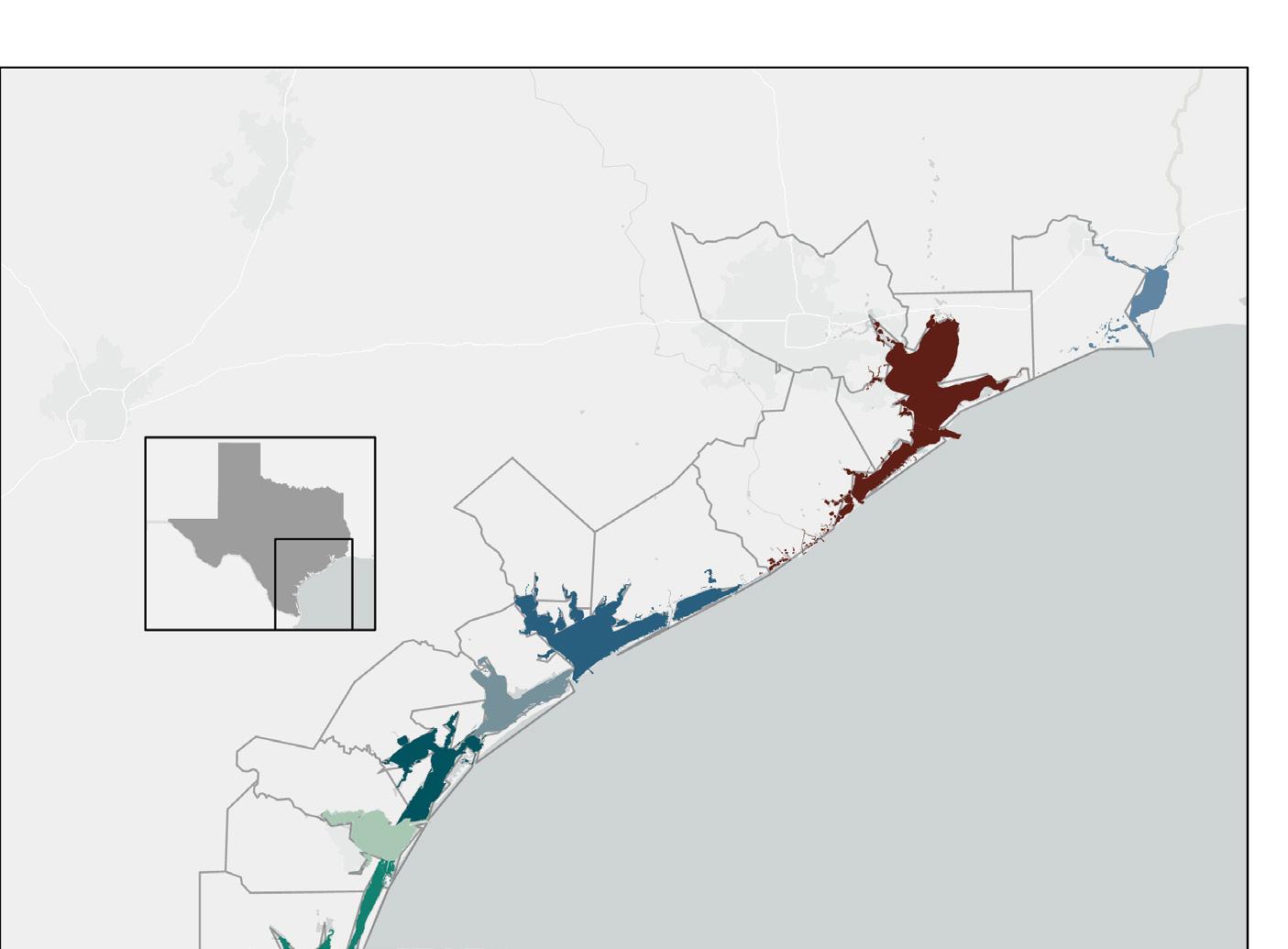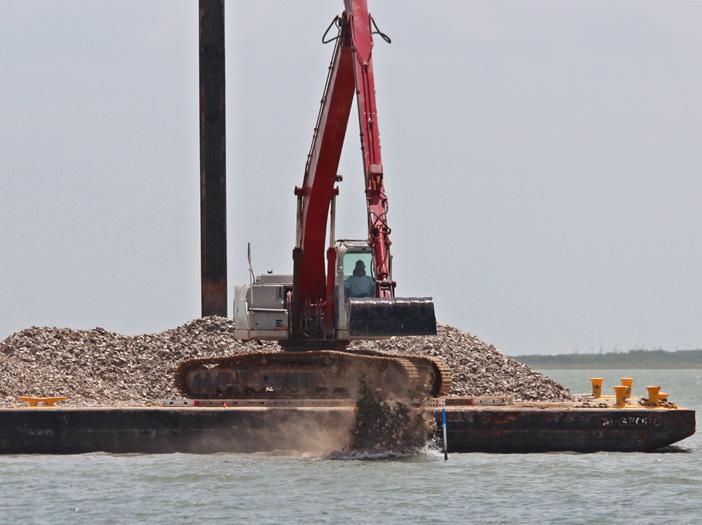The Texas Coast Ecosystem



Health Report Card 2023
Current condition: vulnerable
 Photo by Lizzie Dodds
Photo by Lizzie Dodds




 Photo by Lizzie Dodds
Photo by Lizzie Dodds
The Texas coast is home to diverse estuaries that support fish, birds, and other wildlife, and are vital to local and state economies. From the marshes of Sabine Lake to the seagrass beds of the Lower Laguna Madre, the estuaries contain an incredible array of productive habitats that are shaped by the freshwater, nutrients, and sediment entering from streams and rivers that flow through 200,000 square miles of Texas lands.
Texas’ coastal fisheries and the economies they support are remarkably healthy despite pronounced human population growth and natural stressors. However, some parts of the Texas coast are displaying symptoms of deteriorating water quality, loss of critical habitat, and population declines of iconic wildlife species due to these stressors.

This Report Card uses local, state, and national datasets alongside stakeholder input to evaluate how current conditions compare to long-term trends. This is meant to give a high-level summary of the health of bay ecosystems to inform management decisions for the Texas coast.

A healthy score represents a well-balanced system that supports current uses. A vulnerable score indicates negative influences from human and natural pressures are being observed. An unhealthy score means that measured values are outside the range of what is expected in a balanced, healthy system.
Prioritize proactive solutions
This symbol indicates a priority call to action
Nutrients
Freshwater inflow
Balanced levels of nutrients, like nitrogen and phosphorus, support life in our bays. Nutrient conditions are generally good for much of the Texas coast. Too many nutrients flowing into certain areas, like Upper Laguna Madre-Baffin Bay and Galveston Bay, are leading to periods of excessive algae growth and deteriorating water quality.
The amount and timing of freshwater inflow to estuaries helps regulate salinity and nutrient supply. Bays on the central Texas coast are experiencing more frequent and intense low flow conditions, resulting in higher salinities and stress on sensitive species like oysters and crabs.
The Texas Beach Watch program measures harmful bacteria in the water at recreational beaches to protect human health. While bacteria levels are generally good coastwide, elevated bacteria levels triggered periodic swim advisories in 2021 at beaches around Matagorda, Corpus Christi, Aransas, and Galveston bays. The Texas General Land Office is reviewing locations for bacteria monitoring to ensure all areas are adequately assessed.
1. Develop frameworks for focused freshwater inflows to maintain healthy salinities.
2. Identify pollution sources and enable mitigation strategies.
Coastal habitats provide feeding grounds and shelter for fish, birds, crabs, sea turtles, and shrimp. They protect the coast from damaging waves and erosion and store carbon.

Coastal Texas has experienced net wetland loss since 2001 due to rising sea levels, while coastal development limits space for adaptation. Localized losses of seagrass, from poor water quality and dredging, and tidal flats, from erosion and sea level rise, have also been observed. However, data are currently too limited to fully assess the condition of these habitats.
Increase monitoring of coastal habitats, particularly seagrass and tidal flats, to identify stressors and understand change.
Tidal flats area
Insu cient data
Colonial waterbirds are iconic species that gather in dense colonies to nest on small islands, such as Shamrock Island Preserve in Corpus Christi Bay and Chester Island in Matagorda Bay. Many species are showing up in fewer numbers than in the past because of erosion of nesting islands and degraded feeding habitats.

Assessed waterbird species: Black Skimmer, Great Egret, Reddish Egret, Roseate Spoonbill, Tricolored Heron, Great Blue Heron, Brown Pelican, Caspian Tern, Forster’s Tern
Restore and manage rookery islands to maintain biodiversity and enable recovery of colonial waterbird populations.
Redfish, Spotted Seatrout, and Black Drum have recovered from historic lows to support a vibrant recreational fishing industry in Texas. Populations of Southern Flounder and Blue Crab are declining in many Texas bays. Shrimp are within acceptable ranges, but populations should be closely monitored to ensure continued sustainability. Oyster populations in many areas of the Texas coast are in decline because of storm impacts, increasing salinity, and pressures from unsustainable harvest practices.
1. Assess fishing and environmental pressures to support sustainable management.
2. Promote restoration to improve oyster reef habitats and productivity in the estuaries.
Assessed finfish species: Spotted Seatrout, Black Drum, Red Drum, Atlantic Croaker, Southern Flounder
 Photo by Lyng Imagery
Photo by Larry Ditto Nature Photography
Photo by Lyng Imagery
Photo by Larry Ditto Nature Photography
Coastal communities affect and are affected by the environment and the natural resources that define them. Healthy bays support healthy communities.

Coastal economies provide local jobs, tax revenue, and ways of life. Revenues from commercial fisheries, tourism, and recreation-based economies in Texas' coastal counties have generally grown steadily along with the US economy. Economic growth in the Laguna Madre region has been relatively slow, while earnings have increased more quickly in Aransas and San Antonio Bay areas.
Support tourism and recreational opportunities in a way that enhances the local economy while protecting natural resources for future generations.
Risk factors include income to poverty ratio, single or no caregiver, crowding, communication barrier, unemployment, disability, no health insurance, age 65+, no vehicle access, no internet access.
Community resilience is the ability to adapt to environmental changes and recover from disasters. Coastal communities depend on a healthy ecosystem for food, income, coastal protection, and a sense of place. Habitat loss, unsustainable use, storms, and industrial spills can cause damages to property and livelihoods, increase inequality, and reduce quality of life. Approximately 26% of residents in Texas’ coastal counties have 3 or more risk factors that make them more vulnerable, compared to the US average of about 22%. More than a third of residents in Kenedy, Calhoun, Refugio, Cameron, and Willacy counties are highly vulnerable.
Take actions to improve equity, invest in resources for vulnerable populations, and promote proactive disaster planning to create more resilient communities.
Coastal economies Community resilience
Through dedicated, proactive measures that expand monitoring and address stressors before they reach critical levels, as well as efforts to restore declining wildlife populations and lost habitat, Texas has an opportunity to achieve something that is rarely seen these days—a balance between socioeconomic and environmental needs that leads to healthy ecosystems and prosperous coastal communities.

The Harte Research Institute at Texas A&M University-Corpus Christi's Sink Your ShucksTM Oyster Recycling Program has reclaimed millions of pounds of oyster shells to restore over 40 acres of oyster reef in Texas Coastal Bend bays.

The Bringing Baffin Back Initiative is a partnership of researchers at the Harte Research Institute and the Coastal Bend Bays and Estuaries Program, citizen scientists, local residents, and organizations dedicated to restoring and protecting Baffin Bay.
ReleaSense is a unique partnership with industry, conservation groups, recreational anglers, and scientists at the Harte Research Institute. The initiative increases recreational angler access to information on fishing practices that promote healthy sportfish populations.



This Report Card was developed in partnership with many stakeholders and organizations. This report was made possible in part through a grant from the Texas General Land Office (TGLO) providing Gulf of Mexico Energy Security Act of 2006 funding to the State of Texas and awarded under the Texas Coastal Management Program. The views contained herein are those of the authors and should not be interpreted as representing the views of the TGLO or the State of Texas. Special thanks to Coastal Bend Bays & Estuaries Program, Mission-Aransas National Estuarine Research Reserve, The University of Texas Marine Science Institute, Lower Laguna Madre Estuary Partnership, The University of Texas Rio Grande Valley School of Earth, Environmental, & Marine Sciences, Matagorda Bay Foundation, and San Antonio Bay Partnership.
Suggested citation: West, A., Wetz, M., Beseres Pollack, J. 2023. Texas Coastal Ecosystem Health Report Card. Harte Research Institute for Gulf of Mexico Studies, Texas A&M University-Corpus Christi.
